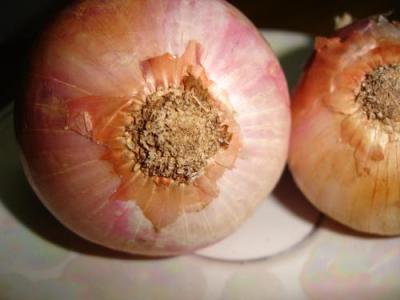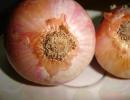
|
Onion
Scientific name:
Allium cepa
Order/Family:
Aspargales: Alliaceae
Local names:
Kitunguu, (Swahili), Gitunguru (Kikuyu)
Pests and Diseases:
Anthracnose
Bacterial soft rot
Botrytis leaf blight
Downy mildew
Fusarium basal rot
Leafmining flies (leafminers)
Onion fly
Onion rust
Purple blotch
Sedges
Slippery skin
Sour skin
Thrips
White bulb rot
|
Anthracnose (Onion smudge) (Colletotrichum circinans)
It usually appears in fields just before harvest and continues to develop during storage period. Under warm and wet soil conditions, it can cause seedling damping-off. The most common symptom is the small dark green or black stains (dots) on outer scales of bulbs. The dots develop concentric rings. In severe cases, the fungus attacks the living tissue causing a collapse of fleshy scales. On coloured onions, the fungus is restricted to the neck of the bulbs making the flattened leaves colourless. The fungus survives on onions, sets and in the soil. Warm moist conditions favour development of the disease.
Optimum temperature for infection is from 23.9 to 29.4° C. White onions are very susceptible to the disease. Reduced market value results from marred bulb appearance and bulb shrinkage. It also attacks leeks and shallots.
- Disease management involves growing coloured varieties where smudge is a persistent problem.
- Harvesting the crop promptly.
- Avoiding exposure to rain between harvest time and storage.
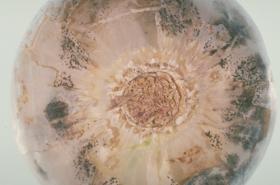
© Courtesy EcoPort (http://www.ecoport.org): Denis Persley
Bacterial soft rots (Erwinia carotovora subsp. carotovora)
This is a big cause of loss in storage onions. Bacteria Erwinia carotovora subsp. carotovora) can enter the neck tissue as plants mature and then invade one or more scales. At this stage, the affected tissues are water-soaked and pale yellow to light brown. As the rot progresses, the invaded fleshy scales become soft.
Diseased bulbs can be diagnosed by pressing on the bulb: a watery, foul-smelling fluid often can be squeezed from the neck of diseased bulbs.
Bacterial soft rot bacteria enter only through wounds. Onion maggots (Delia antiqua) may carry the bacteria and introduce them while feeding. Onions with mechanical injuries, bruises or sunscald under warm, humid conditions are particularly susceptible to bacterial soft rot. Soft rot can affect many vegetables including carrots, celery, potato and parsnip.
- Onion tops should be allowed to mature well before harvesting.
- Care should be taken to avoid bruising during harvesting and packing.
- Storage places should be well ventilated to avoid accumulation of moisture on the surfaces of bulbs.
- Onions should be stored at 0° C and a relative humidity (RH) of 65 - 70%.
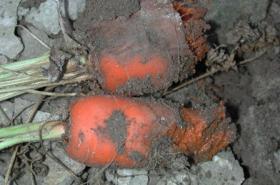
© Oregon State University

Soft rot o…

Onion fly
Downy mildew (Peronospora destructor)
It attacks young plants, appearing as white specks, usually confined to the oldest leaves of young plants. A greyish white mould develops rapidly in cool damp weather and progresses down the sheath, and plants eventually fall over and dry up. Optimum temperatures for fungal growth are between 13 and 20° C. Because of the temperature requirements of the fungus, the disease is more serious in higher cooler areas.
The fungus survives in seeds, bulbs, sets, and on plant debris. Spores are carried long distances by air currents. The fungus can infect onion, Welsh onion, Egyptian onion, garlic, shallot, leek and possibly some other species of Allium.
- Use healthy seeds or sets.
- Use resistant varieties, if available.
- Rotate at least 3-years free of onions or other Allium species (e.g. garlic).
- Wider spacing of plants help reducing humidity and downy mildew.
- Preventative treatments with rock powder can reduce the attack of this disease.

© Courtesy EcoPort (http://www.ecoport.org): Mike Pearson

Downy mild…

Downy mild…
Fusarium basal rot (Fusarium oxysporium f.sp. cepae)
The above ground symptoms constitute yellowing of leaf blades at the tip. The yellowing at later stages covers the whole blade. The affected leaves shrivel and decay. Diseased plants can be easily pulled out because the root system is rotted. Affected roots are dark brown, flattened, hollow and transparent. When diseased bulbs are cut vertically, a brown discolouration is evident. The fungus survives in any soil moisture that permits crop growth. Infection is facilitated by injuries to root system, Losses can occur in the field and in storage.
The disease is most prevalent where onions are grown under high temperature conditions. Although of no economic importance the disease could attack garlic, shallots, chives and leeks. It also can survive in weed, Oxalis corniculata.
- Rotate with non-related crops.
- Avoid root injury.
- Carefully harvest the bulbs.
- Proper cure the bulbs before storage.
- Store the bulbs at 0° C / 65-75% relative humidity is recommended.
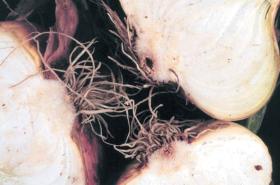
© David B. Langston, University of Georgia, Bugwood.org
Leafminers (Liriomyza spp.)
Leafminers may cause damage to green onions. Damage is largely cosmetic, and mining on leaves may cause rejection of marketed onions, but generally does not affect plant growth. Damage in dry onions and garlic is of little concern unless populations become high to prematurely kill foliage.
- Leafminers are usually controlled by natural enemies, especially parasitic wasps. They can become a problem in areas with a high use of pesticides that kill natural enemies. Leafminers have the ability to develop resistance to pesticides in a short time. For more information on natural enemies click here
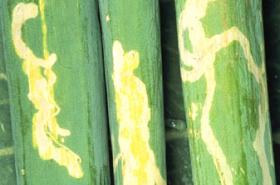
© Courtesy EcoPort (http://www.ecoport.org): P. Ooi
Onion fly (Delia antiqua)
The larvae of the onion fly, also called onion maggot is a major pest of onions. The maggot is small (about 8 mm in size when fully grown), white-cream coloured. It eats the lateral roots, then tunnels into the taproot and sometimes bores into the base of the stem. Attacked leaves wilt and the leaves turn bluish. The plants become shrivelled or eventually die. The maggots feed just above the base of seedlings killing them. A maggot can attack several seedlings in succession. This causes poor plant establishment resulting in many gaps in the field.
The maggots are also found inside developing onion bulbs. Their feeding exposes the plant to infection by diseases such as bacterial soft rot. Pupae are light to dark-brown in colour, and about 7 mm in length. Pupae are found in the soil near the base of the plant. The adult is a brownish grey fly, somewhat smaller than house flies. When at rest, they keep their wings folded one over the other. Adult flies do not cause damage. They lay eggs in the soil surface near the germinating plants.
Onion maggots are adapted to cool, wet weather, so usually they are less of a problem during hot dry periods. They prefer soils heavy in organic matter. The onion maggot attacks plants related to onion such as leeks, shallots and garlic.
- Avoid planting in soils that are high in undecomposed organic matter, such as fields just coming out of pasture or in very weedy conditions. Flies prefer to lay eggs in soil that is moist and with high organic matter. Do not plant onions unless the plant residues are dry and completely decomposed.
- In soils amended with animal manures, allow adequate time for the manure to break down before planting.
- Avoid planting successive onion crops. Practise rotation with crops not related to onions.
- Keep onion fields well separated. Onions grown in the season following an attack by onions flies should be sown as far away from infested land as possible.
- Remove and destroy infested plants and burn them.
- To prevent an infestation with onion flies, carefully plough-under crop residues immediately after harvest.
- Turn soil to destroy pupae.
- Powdered hot pepper or powdered ginger placed around the stems helps when the onion fly population is moderate.
- Neem-based products have a deterrent effect on egg-laying. For more information on neem click here.

© Jarmo Holopainen

Onion fly

Onion fly
Onion rust (Puccinia porri)
Affected leaves show small reddish to dusty orange spots (pustules). These later turn black and are covered until maturity by leaf epidermis. Leaves that are heavily infected turn yellow and die prematurely. A new crop of leaves may develop and the bulb size is usually reduced. The fungus attacks also leek, shallot and some wild species of Allium. The disease is favoured by high humidity coupled with moderate to low temperatures. Also excessive nitrogen in the soil favours disease development.
- Disease management involves rotation, and removal of weed hosts.
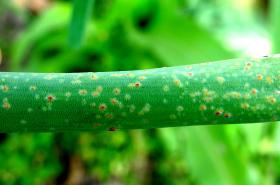
© A.M. Varela, icipe
Purple blotch (Alternaria porri)
Purple blotch attacks onion, garlic, leek and other Allium crops. Initially, small white sunken spots develop on the leaves. These enlarge and under moist conditions, turn purple with a yellowish border and are often covered with a sooty deposit of spores. After 3-4 weeks the leaves turn yellow and collapse. Bulbs may also be attacked, mainly at the neck. This can be seen as a yellow to reddish watery rot.
A good timing of sowing or transplanting can minimise purple blotch attack by A. porri, depending on the local environmental conditions. The fungus requires rain or persistent dew for reproduction. It can grow through a wide temperature range of 6 to 33.8° C. Optimum temperature of fungal growth is 25° C.
- Varieties with waxy foliage are generally more resistant than those with glossy leaves.
- Increased ploughing between seasons may reduce the disease.
- Increased spacing between plants also may reduce disease development.
- Other good practices include seed treatment, rotations, removal of crop debris and planting in well-drained soil.
- Under conventional production system fungicides are used when the disease is severe. In organic production systems no direct measures are allowed.
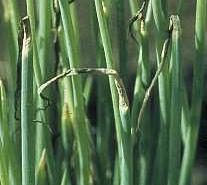
© Courtesy EcoPort (http://www.ecoport.org):W. Gerlach
Slippery skin (Pseudomonas allicolai pv. allicola)
There are no symptoms on the outer surface of bulbs during early stages of disease development. When the bulb is cut open lengthwise, one or more of the inner scales can be found water-soaked or appears as if it has been cooked. The rot does not progress crosswise in the bulb. After the decay has progressed, the tissue begins to dry, the onion shrivels and secondary organisms can enter and cause a wet rot. The base of the bulb can be pressed hard enough to cause the centre core to slip out at the top, and for this reason the disease is known as slippery skin. The disease is favoured by high moisture.
- Proper maturing of the crop.
- Quick drying after harvest.
- Proper storage as in the case of bacterial soft rot.
Sour skin (Pseudomonas cepacia)
In contrast to soft rot and slippery skin, infected scales are not water-soaked but are slimy and yellow. Symptoms usually visible only after onions are dug. The upper portion of the bulb shrinks, and in advanced stages of the disease, the outer dry skin readily slips off during handling while the centre of the bulb still remains firm. Outer layer of scales often becomes darkened and almost orange. Decay of inner scales leads to a soft rot that has a sour, vinegar-like odour. The disease is favoured by wet warm conditions.
- Management measures for the disease are the same as for slippery skin.
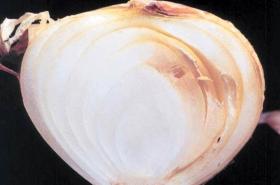
© David B. Langston, University of Georgia, Bugwood.org
Onion thrips (Thrips tabaci)
The onion thrips are major pests of onions throughout Africa. The onion thrips attack an extensive range of crops, including cereals and broadleaved crops. They are tiny (1 mm in length), slender and very mobile insects. Adult thrips are pale yellow to brown in colour. Immature thrips are whitish to pale yellow. Both immature and adult thrips pierce the upper surface of the leaves and feed on the plant sap, generally on the developing leaves, deep inside the plant. This results in white and silvery patches on the leaves.
The excreta of the thrips are clearly visible as small black dots on the silvery leaves. Severe infestations can cause browning of the leaf tips, slowing of plant growth, distortion of leaves and bulbs, and reduction in bulb size. Although thrips feeding during the early bulbing stage is the most damaging to yields, thrips must be controlled before onions reach this stage so that populations do not exceed levels that can be adequately controlled. Onions can tolerate higher thrips populations closer to harvest.
- Thrips infestations are more severe in dry seasons, and entire fields may be destroyed. To prevent infestation, keep plants well irrigated. Dry plants are more susceptible to thrips damage than well watered ones.
- Remove weeds, as the thrips population builds up on them.
- Remove heavily infested plant material.
- For control, neem extracts can be sprayed on attacked plants. However, care should be taken, since some neem preparations, in particular those with high oil content, can be phytotoxic to onions (Schmutterer, 1995).
Therefore, when using a neem-based pesticide for the first time, it should be first tested for phytotoxicity on some plants. For more information on neem click here. - Also a garlic bulb extract can be sprayed thoroughly on the whole plant, preferably early in the morning. Spraying should be particularly directed to the neck area of the plant for good penetration into the plant. For information on garlic bulb extract clik here.
- Spray with insecticide 'Spinosad'. When using pesticides, read product label and ensure pre-harvest interval is observed

© A. M. Varela, icipe
White bulb rot (Sclerotium cepivorum)
The disease occurs mainly in the field and seldom causes injury in storage. The disease is called white rot because of characteristic basal bulb rot where the tissue is covered with white mat of fungal growth. Later numerous rounded black fungal bodies (sclerotia), each about the size of a pin's head, develop. The leaves of diseased plants decay at the base, turn yellow, wilt, fall over and die. The older leaves are the first to die. The roots of affected plants are usually rotted making the plants easy to pull.
Optimum temperature range for infection is from 15 to 18.3° C. The fungus survives in the soil as sclerotia and also in diseased onion sets and wild onion. It is most severe in light cool moist soils. Its host range includes Welsh onion, garlic, leek, shallot and some species of wild onion.
- Plant tolerant, resistant varieties, if available.
- Use healthy seeds.
- Practises long rotation (8-10 years) with cereals.
- Destroy wild onions and leeks.
- Manure from animals fed on diseased plant material should not be used on onion fields.
| General Information and Agronomic Aspects | Information on Pests | |||
| Fresh Quality Specifications for the Market in Kenya | Information Source Links | |||
| Information on Diseases | Contact Information |
 |
| Geographical Distribution of Onion in Africa |
In general, onions are used for salads (bunching onion or sliced full-grown bulbs), pickling (e.g. silverskin onions), cooking (such as in soups) and frying (for example, with meat). Onions are particularly suited to smallholder farming in most countries. It also plays an important role in traditional medicine (e.g. as a diuretic). In the tropics onions can be grown year round where irrigation is possible.
Nutritive Value per 100 g of edible Portion
| Raw or Cooked Onion | Food Energy (Calories / %Daily Value*) |
Carbohydrates (g / %DV) |
Fat (g / %DV) |
Protein (g / %DV) |
Calcium (g / %DV) |
Phosphorus (mg / %DV) |
Iron (mg / %DV) |
Potassium (mg / %DV) |
Vitamin A (I.U) |
Vitamin C (I.U) |
Vitamin B 6 (I.U) |
Vitamin B 12 (I.U) |
Thiamine (mg / %DV) |
Riboflavin (mg / %DV) |
Ash (g / %DV) |
| Onion raw | 40.0 / 2% | 9.3 / 3% | 0.1 / 0% | 1.1 / 2% | 23.0 / 2% | 29.0 / 3% | 0.2 / 1% | 146 / 4% | 2.0 IU / 0% | 7.4 / 12% | 0.1 / 6% | 0.0 / 0% | 0.0 / 3% | 0.0 / 2% | 0.4 |
| Yellow Onions sauteed | 132.0 / 7% | 7.9 / 3% | 10.8 / 17% | 0.9 / 2% | 20.0 / 2% | 33.0 / 3% | 0.3 / 1% | 133.0 / 4% | - | 1.8 / 3% | 0.2 / 10% | - | 0.0 / 3% | 0.0 / 2% | 0.4 |
| Young Onions, Tops only | 25.0 / 1% | 5.6 / 2% | 0.1 / 0% | 1.8 / 4% | 61.0 / 6% | 33.0 / 3% | 1.9 / 11% | 260 / 7% | 4000 IU / 80% | 45.6 / 76% | 0.1 / 3% | 0.0 / 0% | 0.1 / 5% | 0.1 / 8% | 0.7 |
Onions can be grown on any fertile, well-drained, non-crusting soil. The optimum pH range is 6.0 to 6.8, although alkaline soils are also suitable. Onions do not grow well in soils below pH 6.0. On light sandy soils irrigation is necessary. Irrigation could be either overhead or on drip. Onions at the bulbing stage need a substantial amount of water, but excessive moisture must be avoided during the growing season. Avoid application of fresh manure to the crop, as this will cause the plants to develop thick necks and too much leaf at the expense of bulb formation.
Proper seed selection is recommended to minimise problems of splits and doubles. Over-fertilisation, uneven watering, and temperature fluctuations also influence bulb formation. Onion is propagated by seed (most common in the tropics) or sets (immature bulbs ripened during the previous season - in temperate zones).
 |
| Onion nursery |
| © A.A.Seif, icipe |
The ultimate yield of onion is determined by the number of leaves that are formed prior to bulbing.
Common varieties grown in Kenya (short day or day neutral varieties)
- 'Red Creole'. This is a popular standard variety in high demand because of its good keeping quality. It produces mainly single onions from transplants, red, flat-round and with a pungent taste.
- 'Red Tropicana': Red bulbing type
- 'Red Tropicana F1 Hybrid'. Produces large, red, thick flat onions with firm pungent flesh. It is highly productive and therefore demands high levels of management. It keeps well in dry aerated store.
- 'Bombay Red'. It is a variety for dry and warmer conditions. It is small to medium sized, globe shaped, purplish red and pungent.
- 'Yellow Granex FI Hybrid'. This is an early maturing high yielding attractive, thick flat onion with thin yellow scales. The flesh is medium firm, crisp and mild in flavor. The shape and size is uniform leading to higher market prices, and the storage quality is good.
- 'Texas early Grano'. This is a fresh market, early maturing variety (100 - 120 days) with a rather short shelf life. It is yellowish, mild and not very pungent. The bulbs are high top shaped with dry yellow scales. It is a heavy yielder for high altitude regions. Ideal for fish salads.
- 'White Creole'. This is a white variety normally used for dehydration.
- 'Green bunching': Non-bulbing spring onion. It has attractive tasty dark green leaves. It is an early and highly productive onion grown for stems rather bulbs. It is tolerant to sun scotch and it is recommended for salads and fresh market.
When buying seed and not recognizing the variety name as one of the above, ask if it has been grown in Africa before. If not, better stick to a known variety in order not to lose the whole production.
- Nursery seeding and transplanting is the most common and practical option in the tropics. Transplants normally have 3 to 5 well-formed leaves at transplant time. Roots are pruned during planting, in order not to be bent upwards when transferred to the field. This facilitates early establishment of the plant.
- Any germinated bulb of above mentioned varieties would produce 3-6 good size bulbs in about 3 months when planted with the rains. Choose only healthy bulbs for propagation.
- Sets are used in some areas in the temperate zones to ensure large bulb size and uniform maturity. Sets are small dry bulbs, approximately 12 mm in diameter, which have been produced the previous season by seeding thickly or growing under conditions that favour rapid bulbing.
- Direct seedling is possible and gives excellent results where herbicides can be used and the season is sufficiently long to provide early pre-bulbing growth. In the tropics this method is impractical due to enormous weeding costs in an organic system.
Weeding and harvesting are mostly done by hand, although chemical weed control is possible but not organic. Crop rotation is important to avoid the build-up of pests and diseases such as nematodes, Sclerotium and Fusarium.
Nutrient management
Onions respond very well to well decomposed organic manure. Organic manure at 25 to 40t/ha is recommended to obtain high bulb yield.
Freshly harvested onions are dormant and will not sprout for a variable period of time (this depends on the variety). Storage will extend the dormant period. Sprouting will increase in storage temperatures above 4.4°C. It will decrease again as temperatures exceed 25°C.
 |
| © S. Kahumbu, Kenya |
|
Onion thrips (Thrips tabaci) The onion thrips are major pests of onions throughout Africa. The onion thrips attack an extensive range of crops, including cereals and broadleaved crops. They are tiny (1 mm in length), slender and very mobile insects. Adult thrips are pale yellow to brown in colour. Immature thrips are whitish to pale yellow. Both immature and adult thrips pierce the upper surface of the leaves and feed on the plant sap, generally on the developing leaves, deep inside the plant. This results in white and silvery patches on the leaves. | 
Thrips
Thrips damage on onions. Note silvering and blotching of leaves. © A. M. Varela, icipe |
|
What to do:
|
|
Onion fly (Delia antiqua) The larvae of the onion fly, also called onion maggot is a major pest of onions. The maggot is small (about 8 mm in size when fully grown), white-cream coloured. It eats the lateral roots, then tunnels into the taproot and sometimes bores into the base of the stem. Attacked leaves wilt and the leaves turn bluish. The plants become shrivelled or eventually die. The maggots feed just above the base of seedlings killing them. A maggot can attack several seedlings in succession. This causes poor plant establishment resulting in many gaps in the field. | 
Onion fly
Onion fly maggot (Delia antiqua) on onion © Jarmo Holopainen |
|
What to do:
|
|
Leafminers (Liriomyza spp.) Leafminers may cause damage to green onions. Damage is largely cosmetic, and mining on leaves may cause rejection of marketed onions, but generally does not affect plant growth. Damage in dry onions and garlic is of little concern unless populations become high to prematurely kill foliage. | 
Leafminer
Leafminer (Liriomyza spp.) symptoms on onion © Courtesy EcoPort (http://www.ecoport.org): P. Ooi |
|
What to do:
|
- AIC, Ministry of Agriculture and Livestock (2003). Fruits and Vegetables Technical handbook.
- Beije, C.M., Kanyagia, S.T., Muriuki, S.J.N., Otieno, E.A., Seif, A.A., Whittle, A.M. (1984). Horticultural Crops Protection Handbook. KEN/75/028 and KEN/80/017. National Horticultural Research Station, Thika, Kenya.
- Bohlen, E. (1973). Crop pests in Tanzania and their control. Federal Agency for Economic Cooperation (BFE), Germany. ISBN: 3-498-64826-9.
- CAB International (2005). Crop Protection Compendium, 2005 Edition. Wallingford, UK www.cabi.org
- East African Seed Co. Ltd. Africa's Best Grower's Guide www.easeed.com
- Foster, R., Flood, B. (Eds) (1995). Vegetable Insect Management with emphasis on the Midwest. Purdue Research Foundation. ISBN: 0-931682-52-5.
- How to Manage Pests. Onion and Garlic. UC Pest Management Guidelines. UC IPM Online. Statewide Integrated Pest Management Program. University of California. Agriculture and Natural Resources. www.ipm.ucdavis.edu
- Kuepper, G. (2004). Thrips Management Alternatives in the Field. National Sustainable Agriculture Information Service- ATTRA. https://attra.ncat.org
- Ministry of Agriculture and Rural development and Japan International Cooperation Agency (2000). Local and Export Vegetables growing Manual. Agricultural Information Resource Centre, Nairobi, Kenya
- Nutrition Data www.nutritiondata.com.
- Oisat: Organisation for Non-Chemical Pest Management in the Tropics www.oisat.org
- Schmutterer, H. (1995). Effects on Viruses and Organisms. Thysanoptera: Thrips. In: The neem tree Azadirachta indica A. Juss. and other meliaceous plants sources of unique natural products for integrated pest management, industry and other purposes. (1995). Edited by H. Schmutterer in collaboration with K. R. S. Ascher, M. B. Isman, M. Jacobson, C. M. Ketkar, W. Kraus, H. Rembolt, and R.C. Saxena. Pages VCH. Pages 251-254. ISBN: 3-527-30054-6.
- Shanmugasundaram, S. (2001). Suggested cultural practices for onion. Edited by T. Kalb. AVRDC Training guide, AVRDC.
- Sherf, A.F., Macnab, A.A. (1986). Vegetable Diseases and Their Control. 2nd. Edition. John Wiley & Sons Inc. ISBN: 0-471-05860-2.
- The World Vegetable Center Learning Center (Onion) www.avrdc.org
- Youdeowei, A. (2002). Integrated pest management practices for the production of vegetables. GTZ. Integrated Pest Management Extension Guide 4. Published by The Ministry of Food and Agriculture (MOFA) Plant Protection and Regulatory Services Directorate (PPRSD), Ghana with the German Development Cooperation (GTZ). ISBN: 9988-0-1088-5.
- Corner Shop, Nairobi. cls@mitsuminet.com
- Food Network East Africa Ltd. info@organic.co.ke +2540721 100 001
- Green Dreams. admin@organic.co.ke +254721 100 001
- HCDA. md@hcda.or.ke www.hcda.or.ke +2542088469
- Kalimoni Greens. kalimonigreens@gmail,com +254722 509 829
- Karen Provision Stores, Nairobi. karenstoresltd@yahoo.com +25420885552
- Muthaiga Green Grocers, Nairobi
- Nakumatt Supermarket info@nakumatt.net 020551809
- National Horticultural Research Centre, KARI, Thika. karithika@gmail.com. +2546721281
- Uchumi Supermarket info@uchumi.com +25420550368
- Zuchinni Green Grocers, Nairobi +254204448240

 Back
Back
